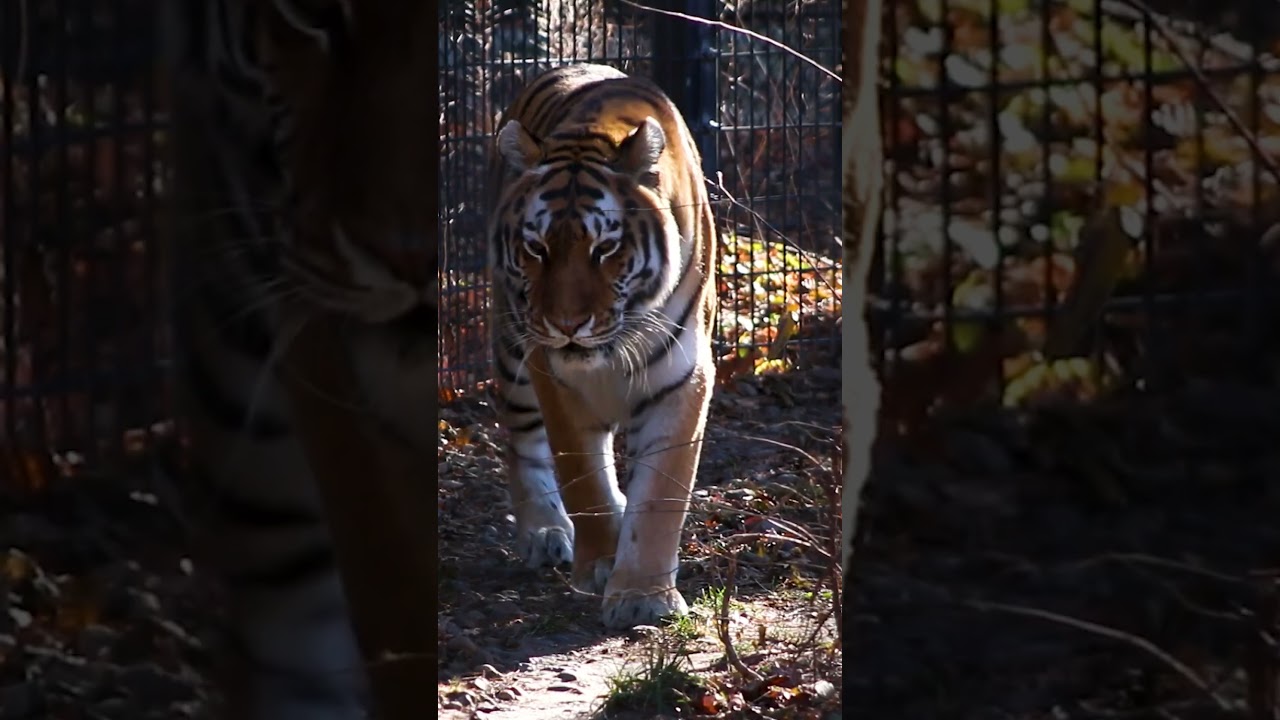– Discovering Misha, the Amur tiger‘s adaptations to the cold at Blank Park Zoo.
– Exploring how seasonal changes enhance the natural behaviors of Siberian-origin big cats.
– Understanding the importance of appropriate habitats for exotic animals in captivity.
As the last leaves begin to surrender to the brisk hug of autumn, Misha finds her stride in a world that starkly contrasts with the one most zoo residents experience. She is an Amur tiger, a magnificent creature whose roots trace back to the frost-covered realms of Siberia. In the confines of Blank Park Zoo, spectators can catch a glimpse of the wondrous interplay between an animal’s native adaptations and the intricate care provided by those who celebrate these majestic beings.
Misha, a majestic feline that creeps through the enclosures of the Blank Park Zoo, exemplifies nature’s grandeur and her species’ remarkable adaptability to the chill of winter. Amur tigers, formerly known as Siberian tigers, are an enthralling showcase of evolution’s ingenuity, built for a land that is often unkind yet mysteriously beautiful. As the mercury dips lower, Misha is not just surviving; she is thriving, painting a mesmerizing picture of wintry wildlife wonders for all who wander near her snowy sanctuary.
To fully appreciate the marvel that is Misha, one must first understand the environment from which Amur tigers hail. Harsh and unyielding, the Siberian landscape is a test of survival that these big cats pass with flying colors. With furry coats that bloom into thick, insulating layers, they boast a resume of biological adaptations that make them the epitome of a winter warrior.
Indeed, Misha’s fur is more than just a luxurious cloak; it’s a multi-layered marvel. The long, coarse guard hairs repel moisture and help snow slide off easily, while the dense, soft underfur traps heat, turning her into an automated, warm-blooded furnace. It’s a natural outfit custom-crafted for the bone-chilling gusts that sweep across her ancestral lands.
But fur alone doesn’t make a tiger fit for the frost. The paws of Amur tigers in the wild are akin to nature’s wide and heavily padded snowshoes, dispersing their already considerable weight, allowing them to tread stealthily over a snow-blanketed terrain. Even within the zoo’s enclosures, Misha’s paws hint at this lineage as she navigates her surroundings with the poise and grace of a seasoned snow dweller.
Observers might note the way Misha’s demeanor shifts with the seasons. This isn’t mere anecdote; it’s a palpable change, reflecting an instinctual exuberance. As temperatures decline, her actions become more pronounced, animated by the crisp air that fills her lungs. She is livelier, her playful antics a dance with the dropping degrees. Those who monitor Misha’s day-to-day can see her embodying the essence of her species, taking to the cooler weather like a painter to a canvas; each paw prints a stroke of artistry.
Amur tigers are solitary hunters in the kingdom of the wild, their territory vast and their presence fleeting. Misha’s environment in the Blank Park Zoo might be less expansive, but it is meticulously constructed to partially mirror her natural habitat’s complexity. Enrichment comes in many forms, from puzzle feeders that ignite the spark of a hunter to scents that whisk her away on an olfactory adventure. Even amid Iowan winters, the temperature’s decline allows her to express a spectrum of behaviors that may lie dormant in summer’s drowsy warmth.
Moreover, the tiger’s preference for cooler climates poses an interesting problem for those dedicated to her care. Big cats are often associated with sweltering jungles or savannas—not the frosty woodlands of Siberia. This presents a unique opportunity for zoos to educate and inspire, unraveling the threads of false narratives and revealing the tapestry of diversity that characterizes the natural world.
Conservation emerges as a central theme when discussing Amur tigers like Misha. Poaching and habitat destruction have whittled the wild populations down to a number that, while recovering, is still precarious. Here, in the safety of her zoo habitat, Misha unconsciously serves as an ambassador for her kind, stirring hearts and minds to the plight of her endangered brethren. The connection guests form with her has the power to fuel the fires of conservation efforts, kindling a desire to safeguard these extraordinary beasts for generations to come.
Yet, there lies a cautionary note in uplifting the story of Misha and her kind. The responsibility to create environments that reflect an animal’s natural leanings falls heavily on those who provide for their care. It is not enough to offer shelter and sustenance—mental and physical well-being must be paramount objectives. To see Misha revel in the wintery blast is to be reminded that a life in captivity, while never a true substitute for the wild, can be sculpted to respect the innate needs of its residents.
It’s not just the chill in the air that invigorates Misha; it’s the authenticity of her experience. The Blank Park Zoo and its facilities bear the weighty task of bridging the gap between the wild world and the curious eyes seeking to understand it. This bridge is constructed with diligent research, relentless dedication to animal welfare, and an unwavering commitment to education.
As we part ways with the image of Misha, her silhouette haloed by her cold-breathed plumes, an invitation lingers. Step beyond the viewfinder, beyond snapshots and shared clips, and delve into the living narrative that surrounds you. In true understanding lies the power to affect change, protect, and perpetuate. May every shiver in the winter’s grasp remind us of our responsibility and the continuous marvel that life presents in all its forms.
*****
Source Description
As the temperatures drop, Misha gets more and more into her element. Amur tigers like her originate from upper Russia, which most people know as Siberia.


